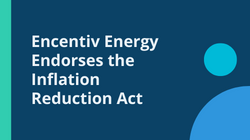
Earlier this week, President Biden signed the Inflation Reduction Act (IRA) into law. This bill, amongst other things, includes a multi-billion dollar investment in clean energy - the largest in the history of the United States. These policies represent a huge step towards making energy efficiency accessible and affordable to all, which are two of the key features of Encentiv Energy’s mission. We commend the United States government for recognizing the importance of energy efficiency to our future.
What is clear from the major components of the IRA is that it will take funding from multiple sources like rebates, grants, tax deductions, and financing to accelerate energy efficiency and decarbonization. These funds need to be set up in such a way that the energy efficiency industry can easily understand how to access them and customers understand how they might influence their decision making.
Some key features of the bill in the commercial and industrial space include:
- $200 million in funding for states to create energy efficiency training programs for contractors.
- $1 billion in funding to support jurisdictions seeking to adopt or improve the implementation of the most up-to-date energy codes, including zero-energy codes.
- Introducing grants and tax credits that can be used to reduce emissions from industrial manufacturing processes.
- Initiatives targeting lower income communities, including $1 billion to go towards energy efficiency projects and sustainability needs in affordable housing.
- A massive expansion of the 179D commercial buildings energy-efficiency tax deduction increases the current maximum $1.88 per square foot to $5 per square foot for both new construction and retrofits to upgrade older buildings.
Over the last 20 years, rate payer funded incentive programs across the country have struggled to develop scalable models to ensure that all customers have awareness and accessibility to rebate dollars. As the IRA funds start to flow down to the states and communities, the industry will need access to tools and resources that aligns with their existing business models and provides clear insight into how to access these funds for their eligible projects.
These highlights do not cover most of the sweeping funding for investments in residential energy efficiency, including grants for Americans to purchase electric vehicles or install solar panels on their homes. This necessary investment will facilitate energy efficiency improvements and projects by eliminating the financial burden that many cannot overcome on their own.
We look forward to seeing more policies that shape the future of energy efficiency for the better.
Further reading
Senate Democrats: Summary of the Energy Security and Climate Change Investments in the Inflation Reduction Act of 2022
The White House: BY THE NUMBERS: The Inflation Reduction Act
The International Code Council: U.S. President signs into law legislation with largest-ever federal investment in building efficiency and sustainable construction
Rewiring America: High-Efficiency Electric Home Rebate Act (HEEHRA)
.png?width=500&name=2019%20e%20news%20spotlight%20logo%20(1).png)



